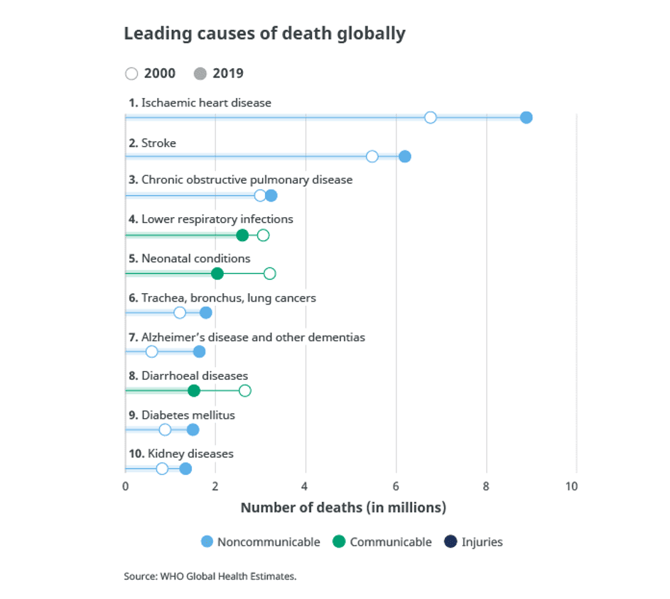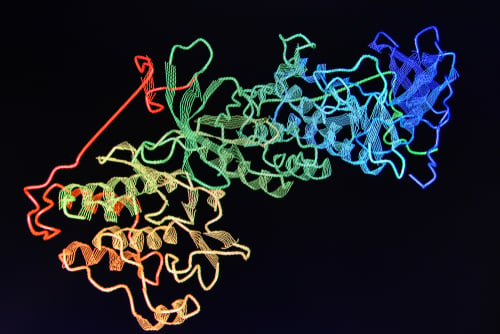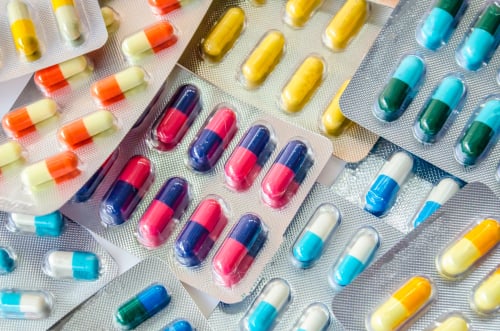Proteins are famous for building muscle, but they are much more than that. Proteomics is the study of protein structures, and how new technologies are deriving solutions to complex diseases and waste management issues.
Key Takeaways
- Proteomics will have more than $30 billion total addressable market by 2027.
- Some of the key players include Merck, Codexis, Abcam, Maravai, Bruker.
- Proteomics can solve some of the biggest threats regarding diseases and waste management.
- The protein folding problem was recently solved by Google's AlphaFold AI computer.
- Next steps include furthering cancer treatments, and finding HIV solutions.
Proteomics market opportunity and players:
As of 2020, the Proteomics market is estimated at $18 billion, with a projected CAGR of 10.7% over the next seven years. In 2027, the market size could be $36.6 billion. The US market is currently estimated at $4.9 billion while China, is forecasted to reach a projected market size of $7.9 billion by 2027 assuming a 14.2% CAGR. Japan, Canada, and Germany are forecasted to grow between 7.3% and 9.2%.
Abcam (ABCM) is a leading producer and distributor of laboratory consumables, such as antibodies for use in life science research settings. The firm supplies a portfolio of reagents necessary for experimentation and therapy development across several scientific disciplines such as cancer treatment, infectious disease, and proteomics. In January of last year, in an attempt to deepen its position in the proteomics space, Abcam acquired Expedeon for $130 million and they estimate a total addressable market for protein capture and conjugation of $2.7 billion in 2024.
Through its Vector labs business, Maravai (MRVI) provides products used to detect the expression of proteins in cells and tissues. MRVI’s protein detection reagents enable scientists to monitor biological processes by seeing how protein expression levels in tissue samples. MRVI states that its protein detection segment is its smallest contributing only $26 million in revenues, or 18% of total company sales last year. They do however understand the fast pace at which Proteomics is growing and could attempt to capture more of the reagents in this market going into 2021.
Bruker (BRKR) has one of the best new product portfolios as they offer innovative high-end tools to address the increasing demand coming from the proteomics market. BRKR has a non-exclusive collaboration with Seer inc (SEER). Seer Inc is an early-stage producer of tools used in the proteomics space. Other competitors in the protein detection segment include, Codexis, Thermo Fisher Scientific, Merck KGaA’s MilliporeSigma, and smaller outfits such as Cell Signaling technologies, Enzo Clinical Labs, and Jackson Immuno-Research.
Deaths are not the problem, diseases are.
The whole idea behind investing in science is because science solves expensive problems, and one such problem is diseases. The graphic below is a rundown of death by disease according to the World Health Organization showing heart disease as the number one cause of death, followed by strokes and pulmonary disease. Beware that this rundown is a global mix, a mix of different countries who weigh in in drastically different ways on certain types of diseases.
People still die of diarrhea today, and most of those deaths occur in low to middle income nations, not developed countries. AIDS/HIV remains a serious health concern in developed nations, but it ranks as the fourth leading cause of death in Africa, even though efforts in curtailing the virus have halved the number of deaths from 1 million in 2000 to 435,000 in 2020. Six of the top ten causes of deaths in low-income countries are from communicable disease such as malaria, tuberculosis, and AIDS.
Wastewater mismanagement causes irrefutable damage to our environment and to humans, as it propagates diseases. By 2050, close to 70% of the world’s population will live in cities compared to 50% today, and most cities still do not have adequate infrastructure and resources to address wastewater problematics. 1.8 billion people use a source of drinking water contaminated with faeces. Globally, it is likely that over 80% of wastewater is released to the environment without adequate treatment and lastly, the costs of wastewater management are greatly outweighed by the economic and health benefits that ensue from proper sustainable treatment.
What is a protein
Proteins are of a fundamental necessity to life, they help your muscles move and grow, and they even help your eyes see light. They are large complex molecules made up of chains of amino acids (sugar) and what the protein does depends in part on what shape it folds into. A protein’s shape is linked with its function, and the ability to predict this shape opens up a whole world of opportunities; imagine developing treatments for the aforementioned diseases more quickly, or finding more efficient enzymes that will break down waste to clean up our oceans and cities? This can be done by mastering the study of proteins, and of the proteome (the proteome is the set of expressed proteins in a given type of cell or organism), through Proteomics.

Proteomics explained
Proteins can be the root cause of a disease, and the good news is that proteins can also cure diseases. A scientific goal should therefore be to better understand the structure of proteins, their contents, their nooks and crannies. Proteomics involves technologies that help identify and quantify the overall proteins present in the content of a cell, tissue, or organism. It supplements other ‘’omics’’ technologies like genomics and transcriptomics to gain clarity on protein structures. The following list are ways in which proteomics-based technologies are being used:
- Detecting various diagnostic markers
- Developing vaccines
- Understanding pathogenicity mechanisms
- Alteration of expression patterns in response to different signals
- Interpretation of functional protein pathways in different diseases.
Proteomics is crucial for early disease diagnosis, prognosis, and to monitor the evolution of diseases, and it also has a vital role in drug development. This is all great, but you might wonder how it achieves this?
Currently, proteomics relies mainly on mass spectrometry (MS) or Cyro-EM, analytical techniques used to measure the mass-to-charge of ions where results usually present a mass spectrum. MS is used to identify unknown compounds via molecular weight identification i.e., it allows one to determine the structure and chemical properties of molecules (such as proteins). Instead of truly sequencing protein, MS classifies a protein, and this typically requires a billion copies of a protein to achieve a successful outcome.
Today, the costs of using this technology run high because proteomics is not as well scaled and developed as genomics and transcriptomics. The utilization of proteomics requires expensive tols, and highly skilled personnel which substantially impact the costs of this technology and thus limits its wider use in society. If an instrument is capable of successfully sequencing proteins like it does with the human genome, the entire group of omics technology could blow up into a revolution.
Next steps in Proteomics
What remains difficult now is quantifying the proteome of cells and tissues as easily as measuring the genome or transcriptome. The increase of data and the penetrating insight that developed from the first draft of the human genome could be expanded to add to the proteome and therefore build a comprehensive outlook of cellular processes for protein research.
The future is also happening right now; Google’s DeepMind surprised the scientific community with AlphaFold, an algorithm that has solved the lifelong problem called the ‘’protein folding problem’’. Basically, the AI predicts the shape of a protein based on the sequencing of its amino acids and even though it took ten seconds to write that, it took over 50 years for scientists to solve this problem.
Proteomics concerns us all because of the SARS-CoV-2 pandemic. Proteomics, and protein structure prediction, could be used for future pandemic responses. For example, AlphaFold was able to predict several protein structures in the SARS-CoV-2 namely, the ORF3a and ORF8. This sort of technology can thus increase the accuracy and pace at which vaccines are developed.
Proteomics and protein engineering are seeing a decent amount of energy on the systems biology, and activity-based protein profiling side. Systems biology is an approach in biomedical research that provides a comprehensive study of the molecular diversity of living systems. Activity based protein profiling is a technology that uses chemical probes that react with classes of enzymes. Both of these are geared towards furthering cancer research. Merck has recently advanced trials for its Islatravir drug, a drug used for HIV treatment that blocks HIV enzymes.

Sources:
https://www.who.int/news-room/fact-sheets/detail/the-top-10-causes-of-death
https://www.unwater.org/water-facts/quality-and-wastewater-2/
https://academic.oup.com/chromsci/article/55/2/182/2333796
https://advances.sciencemag.org/content/6/2/eaax8978/tab-article-info
BoA Global Research





